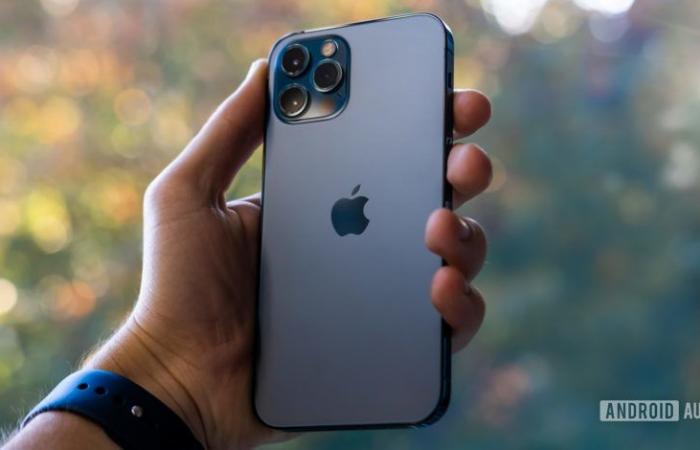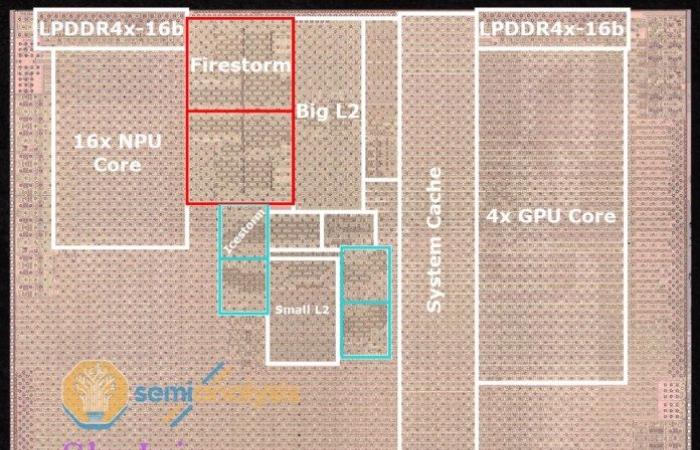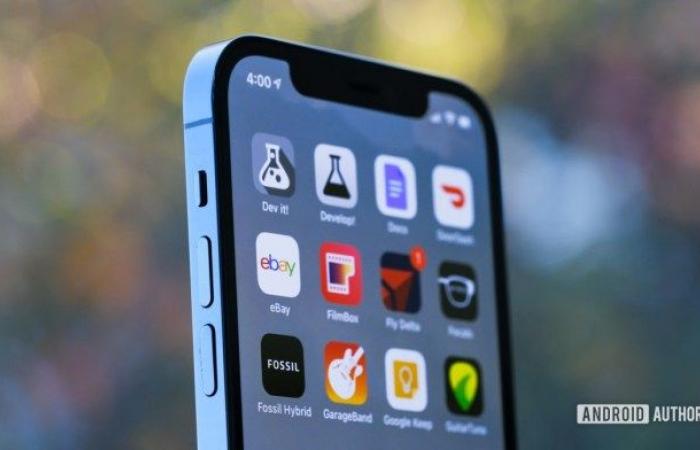Apple has a reputation for being a top-notch chipset designer who delivers lightning-fast performance that has often put its Android competitors to shame. The Apple A14 Bionic is the company’s newest chip that powers the entire iPhone 12 range. It was the first chipset based on TSMC’s latest 5nm process, bringing improvements in performance and energy efficiency beyond the larger 7nm designs of 2020.
During the iPhone launch launch, Apple spent more time comparing the A14 Bionic to the much older A12 than it did to the more modern A13. This indicates smaller performance gains for this generation. With Android phones benefiting from an upgraded Qualcomm Snapdragon 865 Plus model and the Snapdragon 875 just around the corner, the performance gap could be bigger than ever.
We have the iPhone 12 Pro in the house. So we thought we’d run a few benchmarks on the chip to see how it worked. We’ll also dig deeper into what’s new in the Apple chipset.
Continue reading: What is a SoC? Everything you need to know about smartphone chipsets
A closer look at the Apple A14 Bionic
The biggest news with the Apple A14 Bionic is the transition to the industry’s smallest 5nm manufacturing node. Interestingly, though, the analysis suggests that switching to 5 nm only achieved a 1.49-fold reduction in chip size, rather than the 1.8-fold shrinkage for 5 nm claimed by TSMC. The insides are getting more and more difficult of a chip, especially when it comes to memory. Regardless, this isn’t the only new thing about Apple’s newest chip.
Apple is stuck with a Hexa-Core 2 + 4 big.LITTLE CPU architecture design, but is switching to new “Firestorm” and “Icestorm” cores. Apple is targeting laptop-class CPU performance with its new chip, which will potentially serve as the basis for arm-powered Macbooks that will be available later this year. Apple’s efforts in custom CPU design over the years are really starting to break away from the standard parts we’ve seen from Arm. The big question is how well these higher performing cores can maintain their peak performance in a smartphone form factor. Oddly enough, Apple didn’t comment on efficiency during launch.
Apple has spent more on silicon outside of traditional CPU and GPU upgrades.
On the GPU side, Apple is sticking with a 4-core GPU cluster that is built entirely in-house. This layout looks exactly like that of the A13, with any performance improvement being due to clock bumps rather than major improvements in architecture or core count.
The rest of the 11.8 billion transistors, a 38% increase over the A13’s 8.5 billion, can be found in improvements to the 16-core neural engine for AI workloads and image processing. Apple offers 11TOPs of AI inference performance versus 6TOPs in the A13. On paper, that still falls short of the Snapdragon 865’s 15TOPs of AI performance. Those numbers are pretty meaningless, however. TOPs don’t tell us what each operation does and how much power they use to perform.
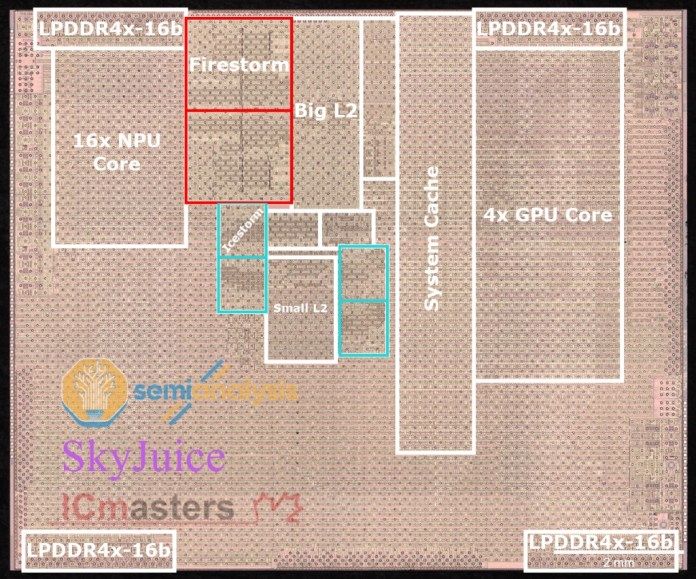

A top metal stamp photo of the Apple A14 with estimated component placements.
The iPhone 12 Pro is also Apple’s first 5G smartphone. Just like the Snapdragon 865, the A14 Bionic doesn’t have a built-in 5G modem. Instead, Apple turned to Qualcomm and paired the chip with a Snapdragon X55 4G and 5G dual-mode modem. This includes mmWave and sub-6 GHz support, 5G FDD, 4G / 5G spectrum coast and support for future-proof stand-alone 5G networks. The speed of the modem is 7 Gbit / s in mmWave networks. Even so, consumers will see much slower speeds. Interestingly, Apple appears to have opted for a slimmer, Chinese-made USI mmWave antenna rather than Qualcomm’s QTM525 found in Android smartphones.
A14 Bionic specifications against Android SoCs
| Apple A14 Bionic | Qualcomm Snapdragon 865 | HiSilicon Kirin 9000 | Samsung Exynos 990 | |
|---|---|---|---|---|
| CPU configuration | 2x firestorm (large cores) 4x Icestorm (small cores) (Fully custom CPU designs) | 1x Cortex A77 bei 3,1 GHz 3x Cortex-A77 bei 2,4 GHz 4x Cortex-A55 bei 1,8 GHz (Semi-Custom CPU Designs) | 1x Cortex-A77 bei 3,13 GHz 3x Cortex-A77 bei 2,54 GHz 4x Cortex-A55 bei 2,05 GHz | 2x Mungo 5. Gen. 2x Cortex-A76 4x Cortex-A55 |
| GPU | 4 Kern (Apple Inhouse Design) | Adreno 650 (+ 10% boost compared to Snapdragon 865) | Mali-G78, 24 Core | Mali-G77, 11 Core |
| AI / DSP | 16-Kern Neural Engine | Hexagon 698 DSP + Tensor Accelerator | 2x large core 1x tiny core | Dual-Core-NPU + DSP |
| RAM | LPDDR4X | LPDDR5 | LPDDR5 / LPDDR4X | LPDDR5 |
| Modem | 4G LTE 5 G unter 6 GHz & mmWave (external) | 4G LTE 5 G unter 6 GHz & mmWave (external) | 4G LTE 5 G unter 6 GHz & mmWave (integrated) | 4G LTE 5 G unter 6 GHz & mmWave (external) |
| process | 5nm | 7nm EUV | 5nm | 7nm EUV |
iPhone 12 Pro benchmark results
Let’s start by comparing the new Apple iPhone 12 Pro with the previous generation iPhone 11 Pro and its A13 processor.
For starters, there is a noticeable jump in CPU performance thanks to the new cores. The single-thread performance jumps by 21% in the popular GeekBench 5 benchmark. The multi-core performance also improved by a respectable 17%. This is due to the change from “Lightning” and “Thunder” CPUs to the new large and small micro-architectures “Firestorm” and “Icestorm”. Plus additional clock rate boosts made available by the smaller 5 nm process.
The overall system performance via AnTuTu also sees a decent jump. This is due to a combination of a faster CPU and GPU. Most of the boost, however, appears to be due to improvements in the storage system, such as Apple’s new compression technology and the large cache system in the chip. There definitely seems to have been a noticeable improvement here – – A total of up to 30% more than compared to the previous generation.
The GPU result is more disappointing. We couldn’t find any improvement in performance between the two phones with 3DMark. This could be due to the special tests of the benchmark and the few additional display pixels that the GPU in the iPhone 12 Pro has to drive. AnTuTu shows a greater increase in GPU performance compared to the last generation chipset, but it is not very large. Even according to Apple’s own estimates, the improvement over the A13 is less than 8%. This time around, it’s definitely a case of minimal graphics performance gains.
Of course, smartphone SoCs these days offer more than just CPU and GPU performance. Apple has also invested a healthy piece of silicon in its AI and image processing components. However, the improvements here are much more difficult to test with benchmarks.
What about Android?
There is a common danger when comparing Apple and Android benchmarks – – They are not a fair comparison. Many benchmarks, especially those that put stress on the GPU, are run with different graphics APIs. Like Apple’s Metal versus OpenGL and Vulkan, which are used by Android phones. Therefore, the results work a little differently, which makes direct comparison quite difficult.
What we can do is compare GeekBench 5’s CPU performance. For others, we need to examine the performance difference between the iPhone 11 Pro and 12 Pro and compare that to a previous comparison we did between the older Apple handset and Qualcomm’s Snapdragon 865 to put us in the right ballpark. So let’s go over the math.
For starters, GeekBench 5 and our own earlier tests give the Apple A13, and therefore the newer A14, a decent single-core CPU lead. With larger cores, however, we previously found the Snapdragon 865 to go head-to-toe and even beat the Apple A13 in multi-core scenarios. The lead was only 8%, so that the new A14 overtook Bionic with its large CPU increase. Even so, the gap is still quite narrow and could easily close again next year.
Apple regains a healthy CPU lead with the A14 Bionic.
Again, we cannot directly compare GPU tests due to the different display resolutions and APIs between the devices. However, the iPhone 12 Pro seems to boost the overall system’s performance significantly. Therefore, it will also extend its lead over the current generation of Android SoCs in this regard. However, the Asus ROG Phone 3 and its Snapdragon 865 Plus offer extremely competitive graphics performance.
Overall, Apple’s A14 currently looks like the fastest chip on the market. However, we should remember that new Android SoCs are currently emerging. You are better positioned to compete against the A14 Bionic. These include the Huawei Kirin 9000 and the Qualcomm Snapdragon 875, which we will test in more detail shortly. With minimal GPU gains in this generation, it is entirely possible that Android phones will fill this long-standing void in 2021.
Apple A14 Bionic Benchmarks: The Verdict
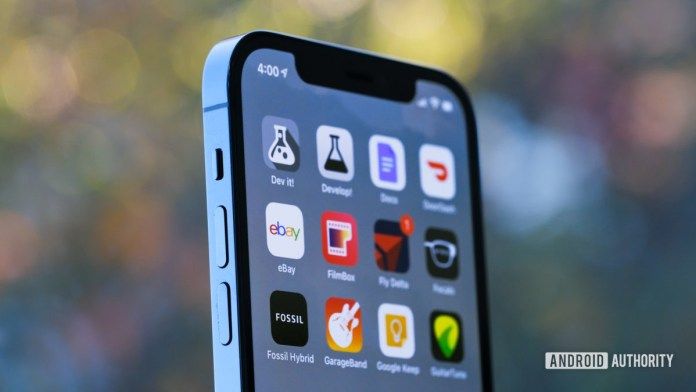

With notable CPU and memory improvements, but limited GPU gains in this generation, the A14 Bionic is a clear sign of Apple’s ambitions. With arm-powered Macs on the horizon, the A14 doubles CPU gains to close the gap between mobile and laptop products and expand Apple’s lead in Android SoCs. The A14 is expected to be the basis for Apple’s laptop chips, albeit with a smaller silicon footprint for graphics and core count.
At the same time, Apple has devoted more silicon than ever to “AI” and photography. Two cornerstones of the heterogeneous computing functions of smartphones. Next-gen Android SoCs will almost certainly follow suit in this regard, but we don’t expect CPU performance to penetrate as far into the laptop realm as Apple. Although Arm’s powerhouse Cortex-X1 could certainly help fill the void. Overall, however, it is Apple’s gaming advantage that is most threatened in the next generation.
Continue reading: Arm Cortex-X1 brings the battle to Apple’s powerful CPUs
The final unknown is how well 5nm helps the chips maintain their peak performance. We’ll get a better picture as soon as these tiny chips come back on the market. We’ll check out how the Apple A14 Bionic fares against the Huawei Kirin 9000 and Qualcomm’s upcoming Snapdragon 875 as soon as possible.
These were the details of the news Still more powerful than Android? for this day. We hope that we have succeeded by giving you the full details and information. To follow all our news, you can subscribe to the alerts system or to one of our different systems to provide you with all that is new.
It is also worth noting that the original news has been published and is available at de24.news and the editorial team at AlKhaleej Today has confirmed it and it has been modified, and it may have been completely transferred or quoted from it and you can read and follow this news from its main source.

